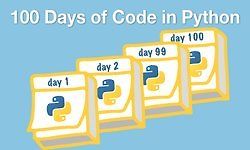-
Урок 1.
00:02:02
Introduction
-
Урок 2.
00:00:54
Installing Python
-
Урок 3.
00:02:30
Integers and Strings
-
Урок 4.
00:02:11
Variables in Python
-
Урок 5.
00:01:34
Solution to coding exercise: creating variables
-
Урок 6.
00:05:18
Methods print(), str(), and int()
-
Урок 7.
00:03:47
Solution to coding exercise: print, str, and int
-
Урок 8.
00:04:51
The format() method
-
Урок 9.
00:03:38
Solution to coding exercise: format()
-
Урок 10.
00:04:23
Getting user input with the input() method
-
Урок 11.
00:01:11
Solution to coding exercise: user input
-
Урок 12.
00:03:58
Creating our own methods in Python
-
Урок 13.
00:02:53
Solution to coding exercise: creating functions
-
Урок 14.
00:09:21
If statements in Python
-
Урок 15.
00:04:37
Solution to coding exercise: if statements
-
Урок 16.
00:02:10
Section 1 assignment video
-
Урок 17.
00:01:32
Our Development Environment
-
Урок 18.
00:05:28
Creating virtual environments for Python development
-
Урок 19.
00:03:33
Our Age application in PyCharm
-
Урок 20.
00:05:13
(aside) Tweaking PyCharm
-
Урок 21.
00:07:37
Understanding JSON and XML
-
Урок 22.
00:04:46
Making our first HTTP GET request
-
Урок 23.
00:04:00
Finding our chair price parsing HTML
-
Урок 24.
00:07:00
Parsing HTML data using BeautifulSoup
-
Урок 25.
00:06:46
Using the price as a number
-
Урок 26.
00:07:56
Installing MongoDB
-
Урок 27.
00:07:20
Introduction to MongoDB
-
Урок 28.
00:06:36
Creating a PyCharm project that uses MongoDB and pymongo
-
Урок 29.
00:06:20
Simplifying lists in Python with list comprehension
-
Урок 30.
00:14:02
Introduction to Object-Oriented Programming
-
Урок 31.
00:06:20
Creating our first class, the Post
-
Урок 32.
00:14:41
Creating a Database class for database interactions
-
Урок 33.
00:03:25
The last few Post methods
-
Урок 34.
00:05:04
Having default parameter values in Python methods
-
Урок 35.
00:02:35
Understanding dates in Python: the datetime module
-
Урок 36.
00:04:55
Verifying that the Post methods all work
-
Урок 37.
00:13:46
The Blog class and @classmethods
-
Урок 38.
00:05:37
Verifying the Blog methods all work
-
Урок 39.
00:09:46
Starting the menu and user interactions
-
Урок 40.
00:06:33
Finalising the Menu class
-
Урок 41.
00:03:38
Finally, running the application!
-
Урок 42.
00:07:55
Introduction to REST APIs
-
Урок 43.
00:07:26
How can we make our own API? What is Flask?
-
Урок 44.
00:09:33
Python cls() and argument unpacking
-
Урок 45.
00:05:23
Creating the User model for our application
-
Урок 46.
00:10:21
Starting developing the User model
-
Урок 47.
00:07:41
Creating the login and register
-
Урок 48.
00:06:32
Finding blogs by a specific author
-
Урок 49.
00:07:10
Allowing creation of blogs and posts
-
Урок 50.
00:04:06
Creating the static resources and templates
-
Урок 51.
00:08:36
Our first template in Jinja2
-
Урок 52.
00:08:02
Beginning CSS styling of pages
-
Урок 53.
00:14:34
The user login page
-
Урок 54.
00:06:13
The user registration page
-
Урок 55.
00:14:53
Using Bootstrap for the first time for great styling
-
Урок 56.
00:09:45
How can we display a list of blogs?
-
Урок 57.
00:08:14
Displaying a list of posts
-
Урок 58.
00:02:04
The Jinja2 if statement for structure control
-
Урок 59.
00:09:15
Creating new blogs (front-end)
-
Урок 60.
00:09:01
Finalising the application by allowing to create posts!
-
Урок 61.
00:05:28
Creating new Python projects in PyCharm 2019
-
Урок 62.
00:06:23
What are Flask Blueprints?
-
Урок 63.
00:05:31
Creating our new app structure
-
Урок 64.
00:03:33
Getting page content with requests
-
Урок 65.
00:04:29
How to find the price on a website
-
Урок 66.
00:03:30
Getting an element's content with BeautifulSoup
-
Урок 67.
00:10:15
Using RegEx to get specific information from a string
-
Урок 68.
00:10:39
Creating our Item model
-
Урок 69.
00:04:06
Adding type hinting to our application so far
-
Урок 70.
00:01:04
Starting up MongoDB and making sure it's working
-
Урок 71.
00:06:24
Preparing our Item model for saving in MongoDB
-
Урок 72.
00:07:43
Inserting Items into MongoDB
-
Урок 73.
00:06:29
Retrieving Items from MongoDB
-
Урок 74.
00:16:37
Notifying users in a simple way when the price is reached
-
Урок 75.
00:08:06
What is an abstract class in Python?
-
Урок 76.
00:10:48
Making more methods generic
-
Урок 77.
00:09:02
Finishing up the Model superclass
-
Урок 78.
00:03:59
How to force a subclass to have properties of a parent class
-
Урок 79.
00:08:24
Type hinting the current object type in a method return
-
Урок 80.
00:23:03
Creating items through the web interface
-
Урок 81.
00:09:38
Styling our site using Bootstrap 4
-
Урок 82.
00:06:33
Creating the Items blueprint
-
Урок 83.
00:13:02
Creating a page to show all items
-
Урок 84.
00:09:52
Creating alerts through the web interface
-
Урок 85.
00:04:27
A couple problems and solutions with our app... and our way moving forward
-
Урок 86.
00:14:56
Introducing stores to our application
-
Урок 87.
00:04:44
Getting rid of items
-
Урок 88.
00:05:41
Testing our app with stores
-
Урок 89.
00:14:00
Dataclasses in Python 3.7
-
Урок 90.
00:09:28
Turning our models into dataclasses
-
Урок 91.
00:04:13
Giving names to alerts in our application
-
Урок 92.
00:03:59
Saving the last item price
-
Урок 93.
00:08:58
Creating stores through the web interface
-
Урок 94.
00:10:44
Editing alert properties
-
Урок 95.
00:03:47
Linking the alert index to the edit page
-
Урок 96.
00:07:19
Editing stores
-
Урок 97.
00:03:39
Deleting alerts
-
Урок 98.
00:01:21
Deleting stores
-
Урок 99.
00:06:06
Registering users
-
Урок 100.
00:06:42
Encrypting passwords in Python with passlib
-
Урок 101.
00:07:27
Logging in
-
Урок 102.
00:07:11
Viewing only your own alerts
-
Урок 103.
00:09:48
What are Python decorators?
-
Урок 104.
00:14:31
Limiting some pages only to logged in users
-
Урок 105.
00:08:38
Adding a navigation bar using Bootstrap
-
Урок 106.
00:10:25
Limiting actions to admins only
-
Урок 107.
00:04:08
Signing up with Mailgun
-
Урок 108.
00:16:54
Sending e-mail with Mailgun
-
Урок 109.
00:06:01
Creating the landing page
-
Урок 110.
00:01:49
Signing up for GitHub
-
Урок 111.
00:02:55
Forking the GitHub repository from the last section
-
Урок 112.
00:03:03
How to install Git on Windows
-
Урок 113.
00:02:08
How to use the Windows Git Shell
-
Урок 114.
00:02:28
How to install Git on Mac
-
Урок 115.
00:01:07
How to install Git on Linux
-
Урок 116.
00:03:39
Cloning the Git repository from GitHub onto your computer
-
Урок 117.
00:07:49
File statuses and stages in Git
-
Урок 118.
00:05:27
How to generate an SSH key for GitHub
-
Урок 119.
00:08:27
Git commands: git commit and git push
-
Урок 120.
00:01:18
Git command: git log to check previous commits
-
Урок 121.
00:03:05
Signing up to Heroku
-
Урок 122.
00:01:01
Installing the Heroku Toolbelt (Command-Line Interface)
-
Урок 123.
00:03:48
Creating a new Heroku app
-
Урок 124.
00:05:09
Getting values from environment variables in Python
-
Урок 125.
00:01:23
Setting the environment variables in Heroku
-
Урок 126.
00:05:57
Setting up Heroku required files in our project so Heroku knows what to run
-
Урок 127.
00:02:22
Committing and pushing the new files to GitHub
-
Урок 128.
00:01:58
Adding servers on Heroku (called 'scaling dynos')
-
Урок 129.
00:02:26
Deploying our app to Heroku
-
Урок 130.
00:02:50
Adding MongoLab to our Heroku app as an add-on
-
Урок 131.
00:02:07
How to create a new MongoLab user
-
Урок 132.
00:02:27
Changing our program's database URI to match MongoLab's
-
Урок 133.
00:03:23
Using the Heroku logs to fix an Internal Server Error
-
Урок 134.
00:02:17
Running our deployed app in Heroku
-
Урок 135.
00:03:19
Another error: using the URI default database
-
Урок 136.
00:04:04
Verifying the app works, and next steps in the course
-
Урок 137.
00:05:41
Creating a DigitalOcean Droplet
-
Урок 138.
00:06:07
Creating a non-root user
-
Урок 139.
00:08:03
Configuring our new user
-
Урок 140.
00:03:34
Installing MongoDB in Ubuntu
-
Урок 141.
00:04:00
Getting our application code
-
Урок 142.
00:11:42
Configuring uWSGI and the system service
-
Урок 143.
00:07:25
Configuring nginx
-
Урок 144.
00:03:35
Creating a cron job in Ubuntu
-
Урок 145.
00:00:28
Course conclusion. Thank you!
-
Урок 146.
00:01:25
Bonus lecture: other courses and next steps






